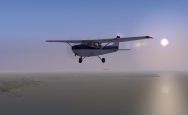| Briefing | August 2016 |
| Overview | The August Event will be a challenge to see just how high you can get. High as a kite? No - high as a C172 actually. |
| Start Time and Place | The event may be flown on any day in August. With it being the summer holidays season, it might prove difficult to gather enough members for a "group outing" to fly with other members. Members are of course free to make their own partnering arrangements if they wish. The Club TeamSpeak channel will provide a "chat" facility as usual. |
| What's it all about? | The challenge is to fly as high as you can before the aircraft simply refuses to climb any more. This is an exercise in coaxing your aircraft to climb another 100 feet, 50 feet even while flying over North Wales where there is no controlled airspace between the ground and the edge of space. You should reach around 15,000 feet. You do have oxygen cylinders and masks for all on board! |
| Flight Planning | You will depart from Liverpool in daylight and fly west to leave the Liverpool zone at Seaforth docks Entry/Exit point. Then cross the Wirral peninsula below 1500ft Liverpool QNH to West Kirby then cross the Dee Estuary to the North Wales coast at Prestatyn. You may now climb to any desired altitude as you continue along the coast to Conwy. After you have completed the challenge, you must return to Liverpool, and enter the Liverpool Control Zone at Oulton Park Entry/Exit point. |
| The Challenge | Once you are west of Conwy, your challenge then is to take your aircraft as high as it will fly. Fly west and back east, south then north, or round in circles - your choice while admiring the view. Clearly it will fly higher if there's not much fuel in the tanks, but remember that you have to return to Liverpool and on shut-down you must have the legal minimum reserve fuel remaining. While climbing, you must remain west and south of Conwy at all times until you start your return journey to Liverpool. If you wish, you can make an FSRecorder file of the last few hundred feet of your climb to show off in the forum. |
| Weather | Do use VATSIM weather. You might even choose your day to get better weather for the challenge, as VFR pilots have to, real world. If the weather isn't so good, at least you will probably get above the clouds from about 5000ft upwards. You then just need to get down again. Perhaps there will be a hole in the clouds, or you may be forced to refile IFR to return to Liverpool. |
| What Aircraft can I fly | This is a challenge of skill, so we all need the same aircraft, loaded in the same way. The default Cessna C172 is therefore the aircraft to fly for this event. You will start your engines on the Liverpool General Aviation apron at the east end with exactly 40% (21.2 US gallons) fuel. You will have three 11 stone (154lbs) people on board including yourself. Your all-up weight should therefore be 2269 lbs before engine start. When you shut down on your return to the Liverpool GA apron, you must have at least 8.0 US gallons of fuel remaining. |
| Plan-G | A Plan-G plan to get you to Conwy and then back to Oulton Park via Ruthin, Gresford and Tarporley (avoiding Hawarden's ATZ) can be downloaded from HERE. It is not mandatory to fly this return route, although entry into the Liverpool CTR at Oulton Park is required. |
| Radio Discipline | Take care not to let our Teamspeak chat cut across ATC. Stop any conversation immediately the R/T comes alive, then continue if "he wasn't talking to us". This is difficult because when transmitting on Teamspeak you can't hear the R/T. So be brief on Teamspeak, and be aware that ATC might be trying to get through. If anyone hears an R/T message which seems to be being ignored, just say "ATC is calling G-CIXN" if you have identified the callsign, or "ATC is calling us" which is a cue for everyone to be quiet on Teamspeak until ATC call again (which they will). Remember too that if asked to "Stand By" by ATC, you do not reply - not even "Roger", but simply wait until you are called again. Remember also that there are several different ATC frequencies in use, and you may not be able to hear when communications are taking place. Make sure you have set and know how to use a Teamspeak mute switch. |
| Acknowledgements | Event planning: Peter Dodds Briefing: Peter Dodds / Tony Driver. |
